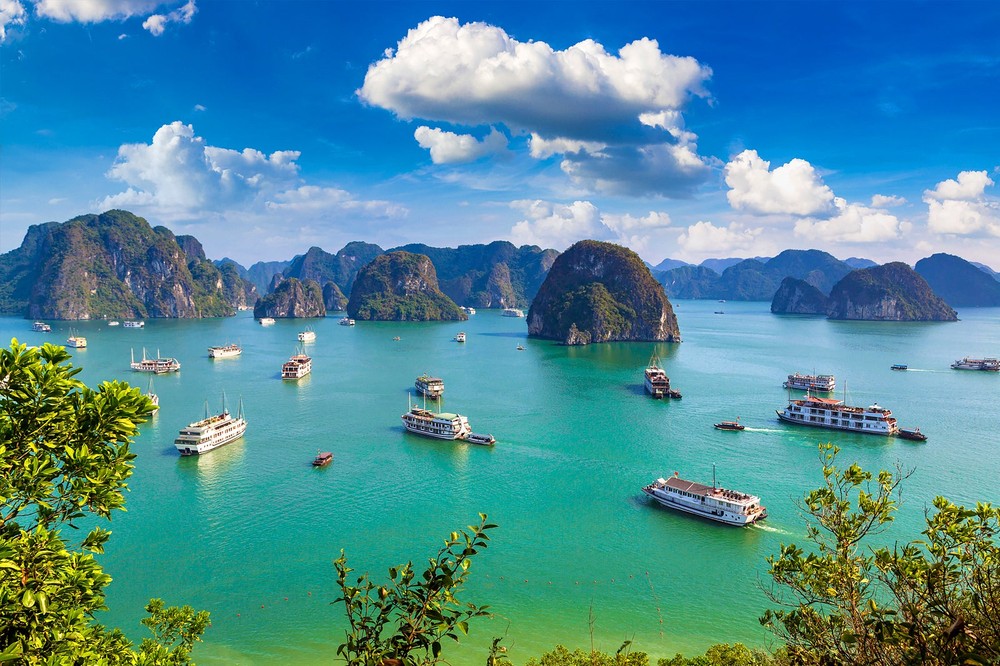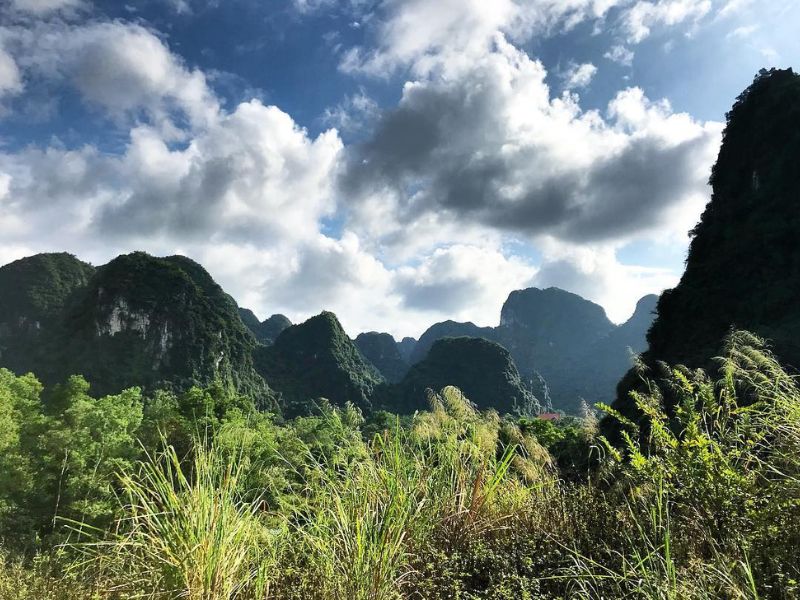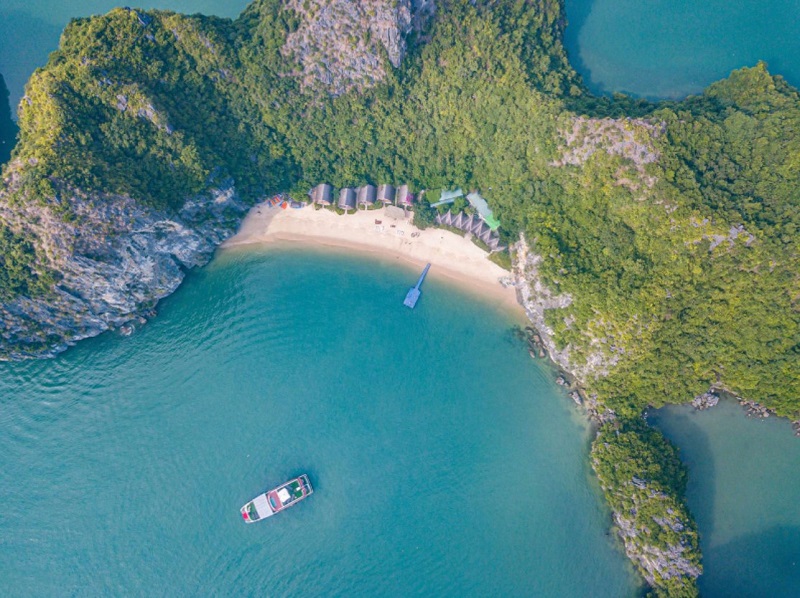Heritage sites in Vietnam hold an undeniable charm, showcasing the country’s deep-rooted history, diverse culture, and stunning natural beauty. Among these, the recently recognized Ha Long Bay-Cat Ba Archipelago stands out. This guide explores why this heritage site is a must-visit, from its diverse ecosystems to breathtaking landscapes.
Ha Long Bay-Cat Ba Archipelago: A Newly Recognized Heritage Site
In September 2023,
UNESCO officially recognized Ha Long Bay-Cat Ba Archipelago as a world natural heritage site, making it a remarkable addition to the list of heritage sites in Vietnam. This inter-provincial site spans Quang Ninh Province and Hai Phong City, making it Vietnam’s first such designation. The recognition underscores the area’s unique natural beauty and ecological significance.
Geographical and Ecological Significance

One of the most famous heritage sites in Vietnam, Ha Long Bay-Cat Ba Archipelago is celebrated for its breathtaking landscape characterized by limestone islands, verdant forests, and crystalline waters. The heritage sites of Vietnam harbor a remarkable diversity of ecosystems, highlighted by Vietnam’s largest maritime forest spanning more than 17,000 hectares.
The archipelago’s scenic beauty and ecological significance make it a haven for nature lovers and an important area for biodiversity conservation efforts. Whether exploring its ancient caves, kayaking through emerald waters, or marveling at the unique flora and fauna, Ha Long Bay-Cat Ba Archipelago offers an unparalleled experience in Vietnam’s natural wonders.
Historical Background
Ha Long Bay was named a world heritage site by UNESCO twice, in 1994 and 2000, while Cat Ba Archipelago was recognized as a World Biosphere Reserve. The combination of heritage sites in Vietnam highlights the region’s historical and cultural significance, including its role during the Vietnam War.
Unique Features of Ha Long Bay
Ha Long Bay – one of the heritage sites in Vietnam is famous for its dramatic limestone islands and islets, karst formations, and emerald waters. These natural features create a mesmerizing seascape that attracts millions of visitors annually. Ha Long Bay is home to approximately 1,600 limestone islands and islets, each with its own distinct shape and character. These islands are often steep and rugged, rising majestically from the emerald waters. The striking formations are the result of millions of years of geological processes, including the erosion of limestone by wind and water.
Read more: Quiet Wonders: Vietnam’s Alternative to Halong Bay
Unique Features of Cat Ba Archipelago
As the largest limestone archipelago in Vietnam, Cat Ba Archipelago includes over 360 islands, with Cat Ba Island being the most prominent, and recognized as one of the heritage sites
in Vietnam. The area is known for its primeval forests, diverse marine life, and unique geological formations.
Cat Ba National Park
 Cat Ba National Park
Cat Ba National Park, situated on Cat Ba Island in northern Vietnam, is a major highlight of the region, offering visitors an unparalleled opportunity to immerse themselves in nature. Established in 1986, the park spans over 26,000 hectares, encompassing both terrestrial and marine ecosystems. Its lush landscapes, diverse flora and fauna, and rich biodiversity make it a must-visit destination for nature enthusiasts and adventure seekers.
Moreover, it offers a unique blend of adventure and tranquility, making it an ideal destination for those looking to experience Vietnam’s natural beauty and biodiversity. Whether hiking through lush forests, bird watching, or exploring ancient caves, visitors are sure to leave with unforgettable memories in one of the heritage sites in Vietnam.
Lan Ha Bay
Often compared to its more famous neighbor, Ha Long Bay,
Lan Ha Bay is a hidden gem that offers a less crowded but equally stunning experience. Located in the south of Ha Long Bay, Lan Ha Bay encompasses over 300 small and large islands, creating a serene and picturesque landscape.

Moreover, Lan Ha Bay is renowned for its emerald waters, which are perfect for a variety of water activities such as swimming, kayaking, and snorkeling. The bay’s waters are clearer and cleaner, providing a beautiful backdrop for exploration. The numerous islands and islets, covered in lush vegetation, add to the bay’s charm and create countless secluded spots for visitors to discover.
One of the most appealing aspects of Lan Ha Bay is its peaceful atmosphere. Unlike Ha Long Bay, which can be bustling with tourists, Lan Ha Bay offers a more tranquil and intimate experience. This makes it an ideal destination for those looking to escape the crowds and enjoy nature in a more relaxed setting.
Conservation Efforts
Conserving heritage sites in Vietnam is critical for maintaining the country’s natural beauty and historical legacy. Both local and international initiatives are actively working to protect and preserve the unique ecosystems of Ha Long Bay-Cat Ba Archipelago. These efforts aim to balance tourism development with the environmental sustainability of heritage sites in Vietnam. Local initiatives include establishing protected areas, enforcing strict regulations, engaging communities in conservation practices, and implementing projects to protect endangered species.
International support, including UNESCO World Heritage status and collaborations with organizations like the IUCN and WWF, provides essential funding, expertise, and technical assistance. Sustainable tourism practices and environmental education further promote conservation by encouraging eco-friendly behaviors among visitors and locals. Together, these efforts ensure that the Ha Long Bay-Cat Ba Archipelago remains a cherished natural wonder for future generations.
Economic and Social Impact
The recognition as a world heritage site has significant economic and social benefits. It boosts local tourism, supports sustainable development, and enhances the area’s global profile. It boosts local tourism by attracting more visitors, supports sustainable development through eco-friendly practices, and enhances the area’s global profile. This status not only generates revenue for local communities but also promotes environmental conservation and cultural preservation, ensuring long-term sustainability and prosperity for the region.
Travel Experience
Visitors to heritage sites in Vietnam can expect an enriching and diverse experience. Those who come to Ha Long Bay-Cat Ba Archipelago can indulge in a diverse array of activities, ensuring an unforgettable experience. From exhilarating kayaking and rock climbing adventures to the mesmerizing exploration of ancient caves and tranquil moments on pristine beaches, there’s something for every traveler.
The best time to visit Ha Long Bay – Cat Ba Archipelago is typically between
April and November when the weather is pleasantly warm and conducive to outdoor exploration and water activities. Whether you’re seeking adventure, relaxation, or cultural immersion, this heritage sites in Vietnam promises a memorable journey amidst its breathtaking natural landscapes and rich cultural heritage.
Conclusion
Ha Long Bay-Cat Ba Archipelago is a unique heritage site that offers something for everyone. From its rich history and vibrant culture to its stunning natural landscapes and diverse wildlife, it is a destination that should not be missed.
If you’re planning your next adventure, consider adding these magnificent heritage sites in Vietnam to your itinerary. These heritage sites in Vietnam provide an unforgettable experience. If you’re interested in this heritage, please follow
this link to learn more.
 One of the most famous heritage sites in Vietnam, Ha Long Bay-Cat Ba Archipelago is celebrated for its breathtaking landscape characterized by limestone islands, verdant forests, and crystalline waters. The heritage sites of Vietnam harbor a remarkable diversity of ecosystems, highlighted by Vietnam’s largest maritime forest spanning more than 17,000 hectares.The archipelago’s scenic beauty and ecological significance make it a haven for nature lovers and an important area for biodiversity conservation efforts. Whether exploring its ancient caves, kayaking through emerald waters, or marveling at the unique flora and fauna, Ha Long Bay-Cat Ba Archipelago offers an unparalleled experience in Vietnam’s natural wonders.
One of the most famous heritage sites in Vietnam, Ha Long Bay-Cat Ba Archipelago is celebrated for its breathtaking landscape characterized by limestone islands, verdant forests, and crystalline waters. The heritage sites of Vietnam harbor a remarkable diversity of ecosystems, highlighted by Vietnam’s largest maritime forest spanning more than 17,000 hectares.The archipelago’s scenic beauty and ecological significance make it a haven for nature lovers and an important area for biodiversity conservation efforts. Whether exploring its ancient caves, kayaking through emerald waters, or marveling at the unique flora and fauna, Ha Long Bay-Cat Ba Archipelago offers an unparalleled experience in Vietnam’s natural wonders. Cat Ba National Park, situated on Cat Ba Island in northern Vietnam, is a major highlight of the region, offering visitors an unparalleled opportunity to immerse themselves in nature. Established in 1986, the park spans over 26,000 hectares, encompassing both terrestrial and marine ecosystems. Its lush landscapes, diverse flora and fauna, and rich biodiversity make it a must-visit destination for nature enthusiasts and adventure seekers.Moreover, it offers a unique blend of adventure and tranquility, making it an ideal destination for those looking to experience Vietnam’s natural beauty and biodiversity. Whether hiking through lush forests, bird watching, or exploring ancient caves, visitors are sure to leave with unforgettable memories in one of the heritage sites in Vietnam.
Cat Ba National Park, situated on Cat Ba Island in northern Vietnam, is a major highlight of the region, offering visitors an unparalleled opportunity to immerse themselves in nature. Established in 1986, the park spans over 26,000 hectares, encompassing both terrestrial and marine ecosystems. Its lush landscapes, diverse flora and fauna, and rich biodiversity make it a must-visit destination for nature enthusiasts and adventure seekers.Moreover, it offers a unique blend of adventure and tranquility, making it an ideal destination for those looking to experience Vietnam’s natural beauty and biodiversity. Whether hiking through lush forests, bird watching, or exploring ancient caves, visitors are sure to leave with unforgettable memories in one of the heritage sites in Vietnam. Moreover, Lan Ha Bay is renowned for its emerald waters, which are perfect for a variety of water activities such as swimming, kayaking, and snorkeling. The bay’s waters are clearer and cleaner, providing a beautiful backdrop for exploration. The numerous islands and islets, covered in lush vegetation, add to the bay’s charm and create countless secluded spots for visitors to discover.One of the most appealing aspects of Lan Ha Bay is its peaceful atmosphere. Unlike Ha Long Bay, which can be bustling with tourists, Lan Ha Bay offers a more tranquil and intimate experience. This makes it an ideal destination for those looking to escape the crowds and enjoy nature in a more relaxed setting.
Moreover, Lan Ha Bay is renowned for its emerald waters, which are perfect for a variety of water activities such as swimming, kayaking, and snorkeling. The bay’s waters are clearer and cleaner, providing a beautiful backdrop for exploration. The numerous islands and islets, covered in lush vegetation, add to the bay’s charm and create countless secluded spots for visitors to discover.One of the most appealing aspects of Lan Ha Bay is its peaceful atmosphere. Unlike Ha Long Bay, which can be bustling with tourists, Lan Ha Bay offers a more tranquil and intimate experience. This makes it an ideal destination for those looking to escape the crowds and enjoy nature in a more relaxed setting.